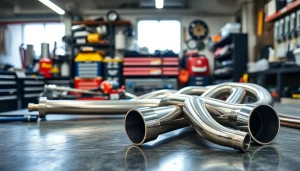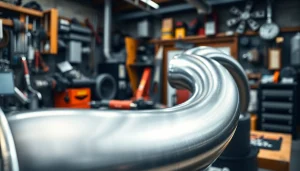Enhancing Engine Performance with Charge Piping: Key Benefits and Insights

In the world of automotive performance, understanding the components that enhance an engine’s efficiency is crucial for enthusiasts and professionals alike. One such component is the charge piping, a critical aspect that influences both airflow and performance in turbocharged and supercharged vehicles. Upgrading your charge piping can significantly impact your vehicle’s performance, providing benefits that extend beyond just aesthetics. In this comprehensive guide, we will delve into the intricacies of charge piping, its components, benefits, installation process, and the transformative effect it has on engine performance.
Understanding Charge Piping
Definition and Function of Charge Piping
Charge piping refers to the pipes and tubes that connect the turbocharger or supercharger to the intercooler and subsequently to the engine’s intake manifold. These pipes are responsible for carrying compressed air generated by the forced induction system to the engine for combustion. Essentially, charge piping plays a pivotal role in managing airflow into the engine, affecting how efficiently the engine performs.
With the right charge piping, vehicles can achieve improved airflow characteristics, reduced turbo lag, and higher boost levels, all contributing to enhanced overall performance. The design and material of charge piping influence how effectively air is transferred, making material choice and pipe diameter crucial factors in maximizing performance.
Materials Used in Charge Piping
Charge piping can be constructed from various materials, with the most common being aluminum, stainless steel, and silicone. Each material has its unique properties and benefits:
- Aluminum: Lightweight and corrosion-resistant, aluminum is favored for its ability to dissipate heat rapidly. It can handle high boost levels effectively, making it a popular choice for performance applications.
- Stainless Steel: Known for its strength and durability, stainless steel can endure high temperatures and pressures. Its robustness makes it suitable for applications in extreme conditions, although it is heavier than aluminum.
- Silicone: Often used in flexible joints and connectors, silicone is advantageous for its ability to withstand high temperatures and resist cracking. It is typically found in combination with metal piping systems to enhance flexibility and ease of installation.
Importance of Charge Piping in Performance Vehicles
The significance of charge piping cannot be overstated in performance vehicles. Upgraded charge piping reduces airflow resistance and enhances turbo efficiency, thereby improving engine response times. Furthermore, by minimizing the risk of pressure loss, optimized charge piping systems ensure that more compressed air reaches the engine, allowing for better combustion. This direct correlation between charge piping and overall engine performance makes it an essential upgrade for anyone looking to boost their vehicle’s capabilities.
Benefits of Upgrading Charge Piping
Improved Airflow and Efficiency
One of the most immediate benefits of upgrading charge piping is the improvement in airflow and efficiency. Stock charge pipes are often made of restrictive materials like plastic or rubber, which can swell under pressure and decrease airflow. In contrast, upgraded charge pipes made from materials like aluminum or stainless steel maintain a consistent diameter and do not expand under pressure, allowing for a smoother and more efficient airflow path.
This reduction in airflow resistance can result in a measurable increase in horsepower and torque, providing the driver with a more responsive engine that can maintain higher boost levels for longer durations.
Boosting Engine Response and Performance
With upgraded charge piping, engines can experience a quicker throttle response. This enhanced responsiveness is largely due to the improved airflow characteristics mentioned earlier. An efficient charge piping system helps maintain boost pressure, allowing the engine to react faster when the driver accelerates. Additionally, with reduced turbo lag, drivers can enjoy a more dynamic driving experience, particularly in turbocharged vehicles where responsiveness is key to performance.
Preventing Common Failures in Stock Systems
Stock charge piping systems can often suffer from failures due to their design restrictions. Common issues include leaks at the connections, swelling of the pipes, and cracks in plastic components due to thermal cycling. Upgrading to a more robust charge piping system significantly reduces these risks. Enhanced materials and engineering mean that the upgraded systems are better equipped to handle the pressures and temperatures involved in forced induction applications.
Types of Charge Piping
Different Materials: Aluminum vs. Steel
As previously discussed, aluminum and stainless steel are the leading materials used for charge piping. Both offer advantages depending on the application:
- Aluminum: Best suited for those looking to save weight while ensuring excellent heat dissipation. It is ideal for many performance-focused systems.
- Stainless Steel: A go-to choice for those in need of durability and strength, making it suitable for extreme applications or off-road vehicles.
The choice between aluminum and stainless steel should depend on the specific needs of the vehicle and the driving conditions expected.
Custom vs. Off-the-Shelf Charge Piping
Vehicle owners often face the choice between custom-built charge piping and off-the-shelf options. Off-the-shelf systems provide a direct replacement for stock components and are typically engineer-designed to fit without modification. They are convenient and often come with tested performance benefits.
On the other hand, custom piping offers the flexibility to adapt to unique setups or aesthetics. For vehicles with unusual configurations or those seeking specific performance goals, custom charge piping can be tailored to optimize airflow and achieve desired performance outcomes.
Choosing the Right Charge Piping for Your Vehicle
Selecting the right charge piping requires consideration of several factors, including the type of forced induction system, vehicle model, and intended use. Drivers should consult with specialists or refer to specific performance goals when making their decisions. Additionally, integrating compatible materials and ensuring proper fitment will enhance overall performance and reliability.
Installation Process for Charge Piping
Tools Needed for Installation
Installing charge piping requires specific tools to ensure a proper fit. Essential tools include:
- Socket wrench set
- Screwdrivers (flathead and Phillips)
- Pliers
- Utility knife (for cutting silicone hoses)
- Torque wrench (for proper tightening of bolts)
- Market-specific tools (such as custom sweeps or bends based on vehicle requirements)
Step-by-Step Installation Guide
1. Preparation: Begin by ensuring the engine is cool and the battery is disconnected. This will prevent any electrical shorts or burns during installation.
2. Removal of Stock Charge Piping: Carefully detach the factory charge piping by loosening hose clamps and removing any brackets or fasteners holding it in place.
3. Assess Fitment: Before installing the new charge piping, lay out the new components and determine how they fit with existing engine components. Ensure smooth pathways free from obstructions.
4. Install New Charge Piping: Connect the new charge pipes starting from the compressor outlet and working towards the intake manifold. Ensure proper alignment and secure all joints with appropriate hose clamps.
5. Final Checks: Double-check all connections for tightness and ensure that there are no loose components that could lead to leaks.
6. Reconnect Battery and Test: After successful installation, reconnect the battery and start the engine to check for any leaks or irregular sounds. A test drive is recommended to assess performance improvements.
Common Mistakes During Installation
Installation can often go awry due to common errors. Here are a few pitfalls to watch out for:
- Insufficient Tightening: Failing to properly tighten hose clamps can lead to air leaks, which diminishes performance.
- Ignoring Fitment Issues: Failing to properly assess fitment prior to installation can lead to misalignment, potentially causing other components to become damaged.
- Forgetting to Test: Not conducting a test drive post-installation can leave performance issues undetected, which could lead to greater problems down the line.
Performance Metrics and Testing
Measuring the Impact of Charge Piping on Performance
To fully appreciate the benefits of upgraded charge piping, it’s essential to quantify its impact through performance metrics. Common methods of measuring changes include:
- Dyno Testing: Utilizing a dynamometer provides precise data on horsepower and torque before and after the installation of model-specific charge piping.
- Boost Pressure Monitoring: By installing a boost gauge, drivers can monitor build-up and responsiveness, providing insight into how effectively the charge piping is managing airflow.
- Vehicle Feels: Beyond data, many users report improved throttle responsiveness and a more aggressive engine note, both of which can be evaluated during real-world driving scenarios.
Understanding Dyno Results
Dyno results offer a direct comparison of vehicle performance pre and post-installation of charge piping. Higher horsepower figures, reduced turbo lag, and an increase in torque are indicators of a successful upgrade. Understanding how those metrics correlate to specific RPM ranges can help optimize usage and understand how the vehicle performs across the power band.
Customer Testimonials and Case Studies
Real-world experiences validate the theoretical benefits of upgraded charge piping. Many enthusiasts report significant performance gains after making this upgrade. From noticeable improvements in speed and acceleration to enhanced engine response, testimonials provide substantial anecdotal evidence in favor of quality charge piping upgrades. Case studies frequently highlight vehicles that, previously limited by stock charge piping, have transformed into high-performance machines merely through the addition of better piping solutions.






